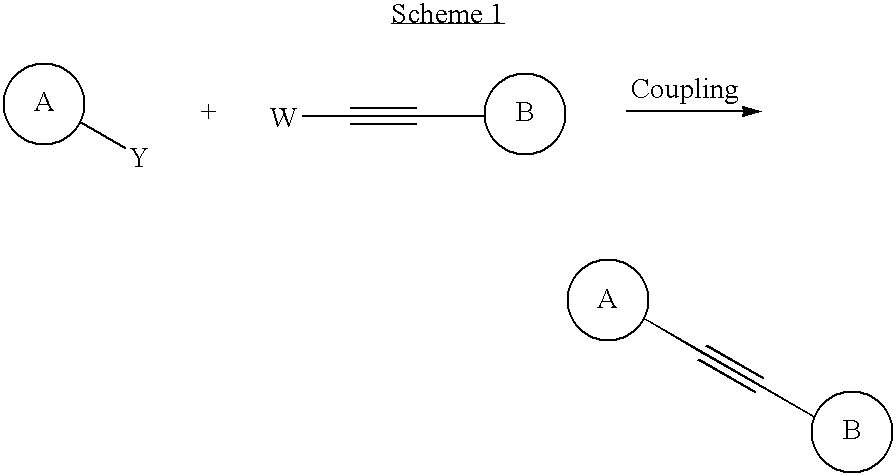Alkyne derivatives as tracers for metabotropic glutamate receptor binding
a technology of metabotropic glutamate and derivatives, which is applied in the direction of heterocyclic compound active ingredients, biocide, drug compositions, etc., can solve the problems of mutual annihilation of two particles, and achieve the effect of facilitating the study of metabolic conditions
- Summary
- Abstract
- Description
- Claims
- Application Information
AI Technical Summary
Benefits of technology
Problems solved by technology
Method used
Image
Examples
example 1a
3-Methoxy-5-[(2-methyl-1,3-thiazol-4-yl)ethynyl]pyridine d3
[0112]
[0113] To a degassed solution of triethylamine (20 mL) and DMF (20 mL) was added 4-bromo-2-methyl-1,3-thiazole d3 (1.5 g, 8.3 mmol), Pd(PPh3)4 (0.5 g, 0.4 mmol), CuI (0.016 g, 0.08 mmol), and 3-ethynyl-5-methoxypyridine (1.1 g, 8.3 mmol). The solution was heated to 70° C. for 18 h, cooled to ambient temperature, diluted with diethyl ether and extracted with water (×3), dried over MgSO4, filtered and evaporated. The crude material was purified by column chromatograph on SiO2 with 10 to 50% EtOAc / Hexanes as eluent to yield a white solid. 1H-NMR (CDCl3, 500 MHz) □ 8.42 (s, 1H), 8.30 (d, 1H), 7.46 (s, 1H), 7.36 (m, 1H). MS (ESI) 234.0 (M++H).
example 1b
5-[(2-Methyl-1,3-thiazol-4-yl)ethynyl]pyridin-3-ol d3
[0114]
[0115] To a solution of CH2Cl2 (20 mL) and 3-methoxy-5-[(2-methyl-1,3-thiazol-4-yl)ethynyl]pyridine d3 (0.10 g, 0.43 mmol) was added AlBr3 (2.15 mL in CH2Cl2, 2.15 mmol). The solution was stirred at ambient temperature for 3 h, quenched with 10% NaOH, extracted with CH2Cl2 (×3), and the aqeuous layer neutralized with 10% HCl. The aqueous layer was extracted (×3) with CH2Cl2, dried over MgSO4, filtered and evaporated. The crude material was purified by RPHPLC to yield a white solid. 1H-NMR (d3-MeOD, 500 MHz) 8.18 (s, 1H), 8.11 (d, 1H), 7.76 (s, 1H), 7.38 (m, 1H). MS (ESI) 220.1 (M++H).
Compound 7
3-Bromo-5-methylbenzonitrile
[0116]
[0117] A mixture of 1,3-dibromo-5-methylbenzene (4.97 g, 19.9 mmol), copper (I) cyanide (2.70 g, 30.1 mmol), pyridine (4.85 mL, 60.0 mmol), and N,N-dimethylformamide (35 mL). were heated at 153° C. for 6 h. The reaction was allowed to cool to ambient temperature, poured into a solution of H2O (200 ...
example 2
[11C] 3-methoxy-5-[(2-methyl-1,3-thiazol-4-yl)ethynyl]pyridine d3
[0126]
[0127] An N-14 gas target containing 1% oxygen was irradiated with an 11 MeV proton beam generating [11C]CO2. The [11C]CO2 was trapped at room temperture inside ⅛″ o.d. copper tubing packed with graphite spheres (carbosphere), isolated from the atmosphere by switching a four-port, two-way valve, and set inside a lead container. The [11C]CO2 was transported to the radiochemistry laboratory. The [11C]CO2 was converted to [11C]MeI using a GE Medical Systems PETtrace MeI Microlab. The [11C]MeI produced was trapped in a 0° C. mixture of 5-[(2-methyl-1,3-thiazol-4-yl)ethynyl]pyridin-3-ol d3 (Compound 6, 0.3 mg) in DMF (0.2 mL) containing cesium carbonate. When the amount of radioactivity in this mixture peaked, the mixture was transferred to a vial at 100° C. containing a small amount of cesium carbonate. The reaction mixture was heated for four minutes at 100° C., diluted with H2O (0.8 mL) and injected onto the HPLC ...
PUM
| Property | Measurement | Unit |
|---|---|---|
| Force | aaaaa | aaaaa |
| Electric charge | aaaaa | aaaaa |
| Electrical conductance | aaaaa | aaaaa |
Abstract
Description
Claims
Application Information
 Login to View More
Login to View More - R&D
- Intellectual Property
- Life Sciences
- Materials
- Tech Scout
- Unparalleled Data Quality
- Higher Quality Content
- 60% Fewer Hallucinations
Browse by: Latest US Patents, China's latest patents, Technical Efficacy Thesaurus, Application Domain, Technology Topic, Popular Technical Reports.
© 2025 PatSnap. All rights reserved.Legal|Privacy policy|Modern Slavery Act Transparency Statement|Sitemap|About US| Contact US: help@patsnap.com



